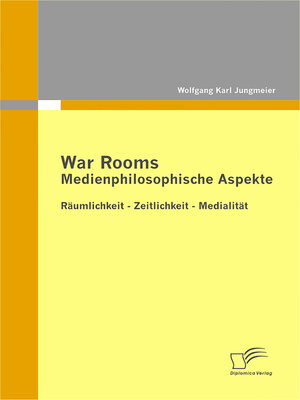War Rooms
ebook ∣ Medienphilosophische Aspekte: Räumlichkeit--Zeitlichkeit--Medialität
By Wolfgang Karl Jungmeier

Sign up to save your library
With an OverDrive account, you can save your favorite libraries for at-a-glance information about availability. Find out more about OverDrive accounts.
Find this title in Libby, the library reading app by OverDrive.



Search for a digital library with this title
Title found at these libraries:
| Library Name | Distance |
|---|---|
| Loading... |
Dieses Buch zeigt die Ursprünge und historischen Weiterentwicklungen des Konzepts "War Room". Darüber hinaus erfolgt eine kritische Analyse der philosophischen Grundaspekte Medialität, Räumlichkeit und Zeitlichkeit in Bezug auf War Rooms.
War Rooms waren ursprünglich Kommandozentralen für den militärischen Bereich, in erster Linie darauf ausgerichtet, Entscheidungsfindungen zu optimieren. Die Weiterentwicklungen dieser geschichtlichen Konzeption sind insofern höchst bedeutsam für die Gegenwart, da sie als Vorlagen für heutige Entscheidungszentren in Politik und Wirtschaft dienen. Trotz dieser Relevanz wurde die Thematik bisher kaum bearbeitet.
Das Buch besteht aus drei Teilen: Erstens wird die historische Entwicklung der Idee des Feldherrn anhand einer vierteiligen Feldherrntypologie nachgezeichnet (genialer, technokratischer, technisch-psychologischer und informatisierter Feldherr). Zweitens werden drei bedeutsame geschichtliche Beispiele für War Rooms angeführt (Schlieffenplan, Cabinet War Rooms, White House Situations Room), die sich jeweils auf einen der drei letzten Feldherrntypen beziehen. Schließlich werden die herausgearbeiteten Feldherrnstufen hinsichtlich medienphilosophischer Aspekte analysiert. This book evaluates the origins as well as the historical advancements of the War Room conception. Additionally, a critical analysis of the War Room's philosophical aspects, mediality, spatiality, and temporality is provided. Originally, War Rooms were command centers for the military domain, primarily set up to optimise decision-making. The advancements of this historical conception are highly relevant, because they serve as role models for command centers in current politics and business. Even with this relevance, the topic of this book has hardly been covered until now.
This book consists of three main parts. The first part focuses on the historical development of the idea of the commander that is based on a four-part typology; ingenious, technocratic, technical-psychological, and informatised commander. The second part cites three historically important examples - Schlieffenplan, Cabinet War Rooms, and White House Situations Room - that each correspond with one of the three latter types of commanders. The last part offers an analysis on the previously elaborated levels of the commander as they pertain to the mediaphilosphical aspects.







